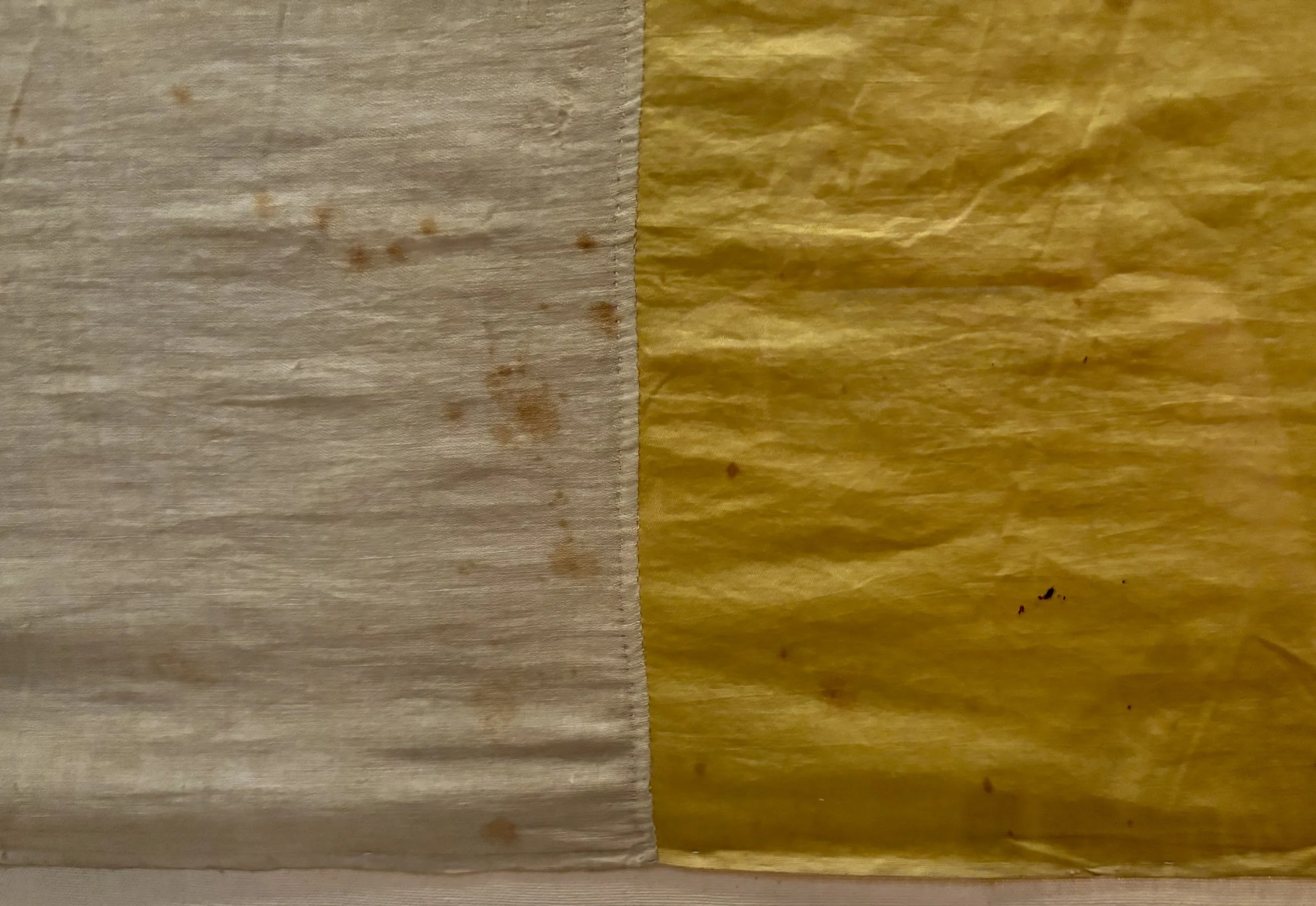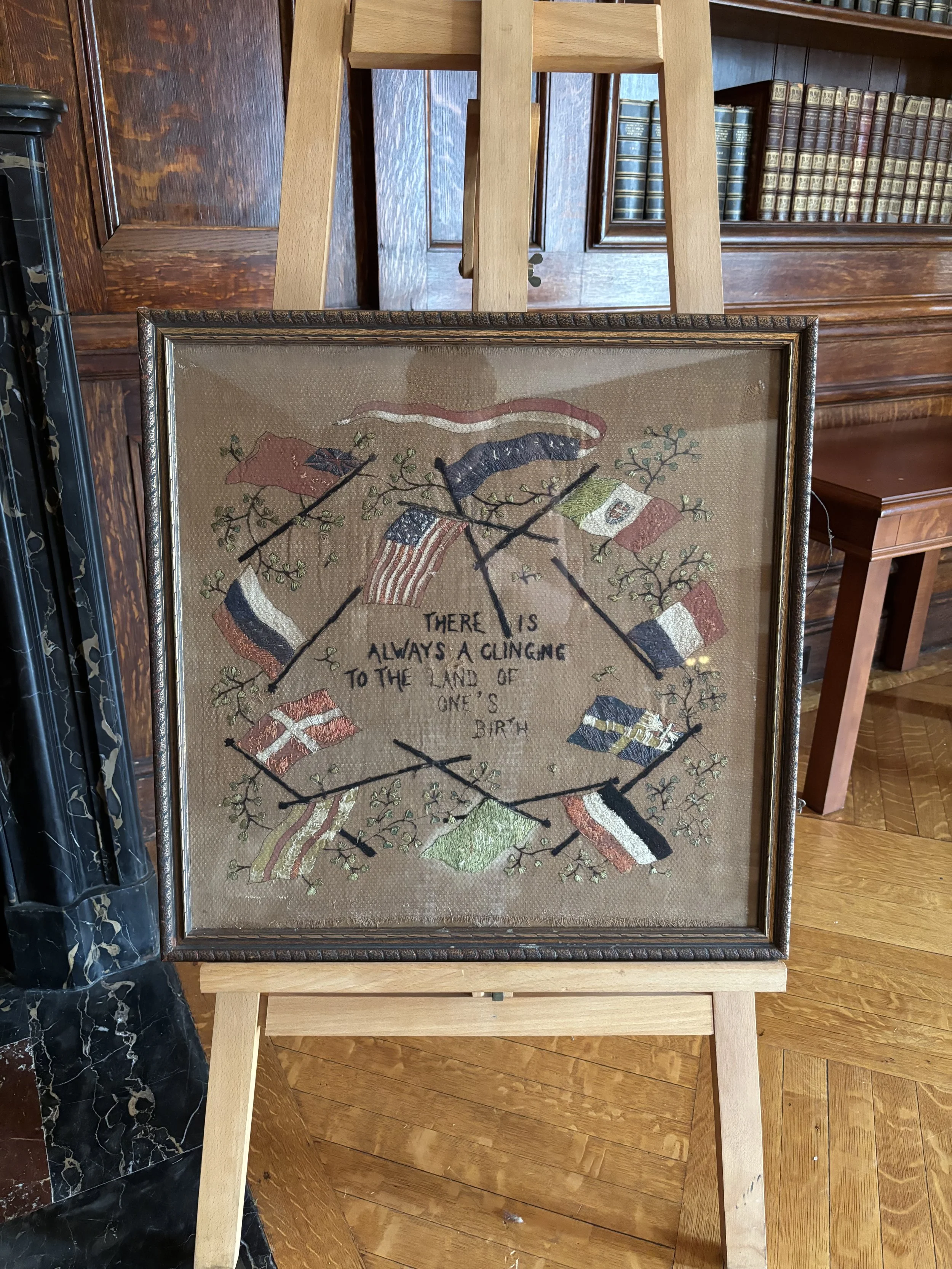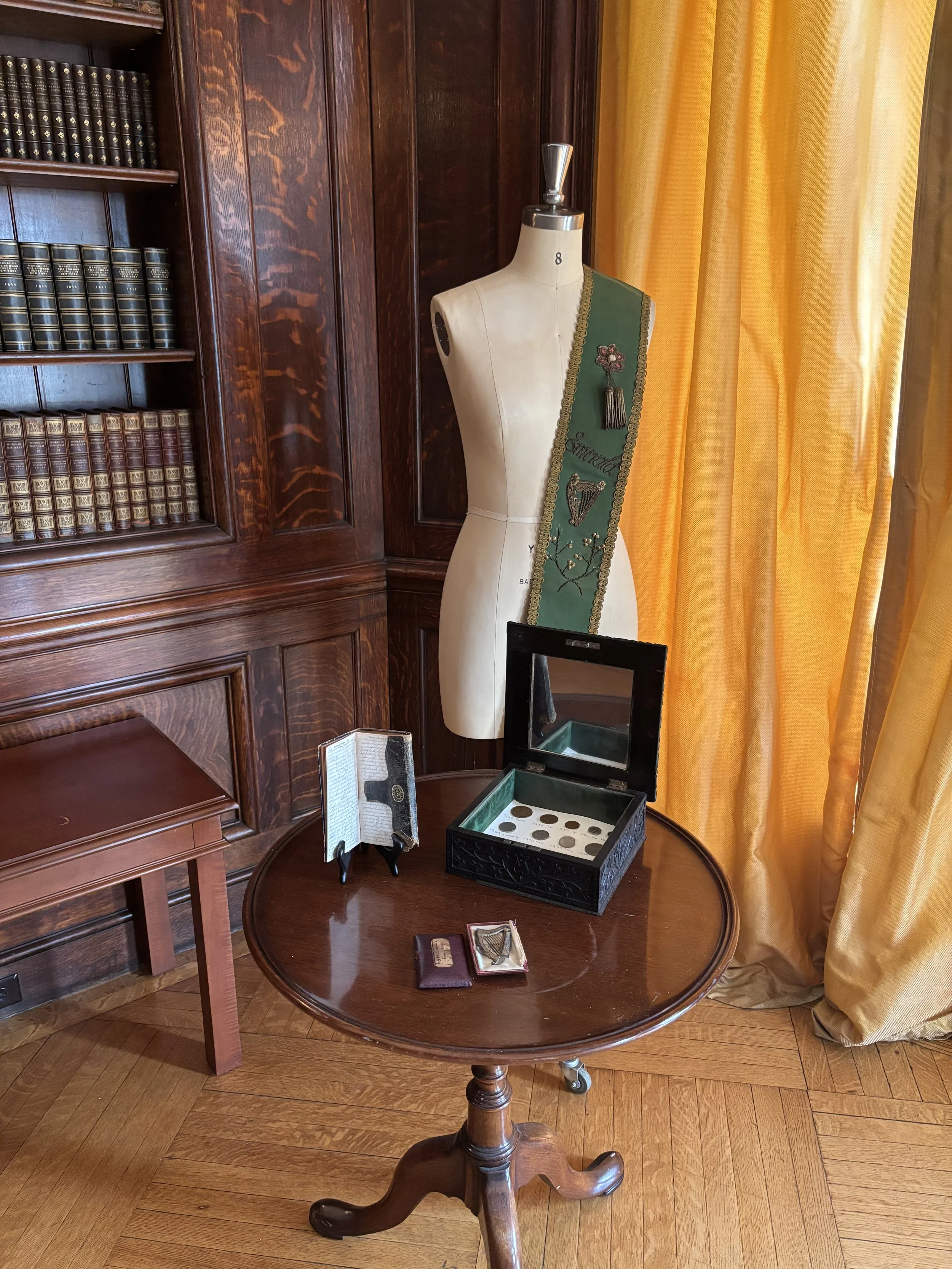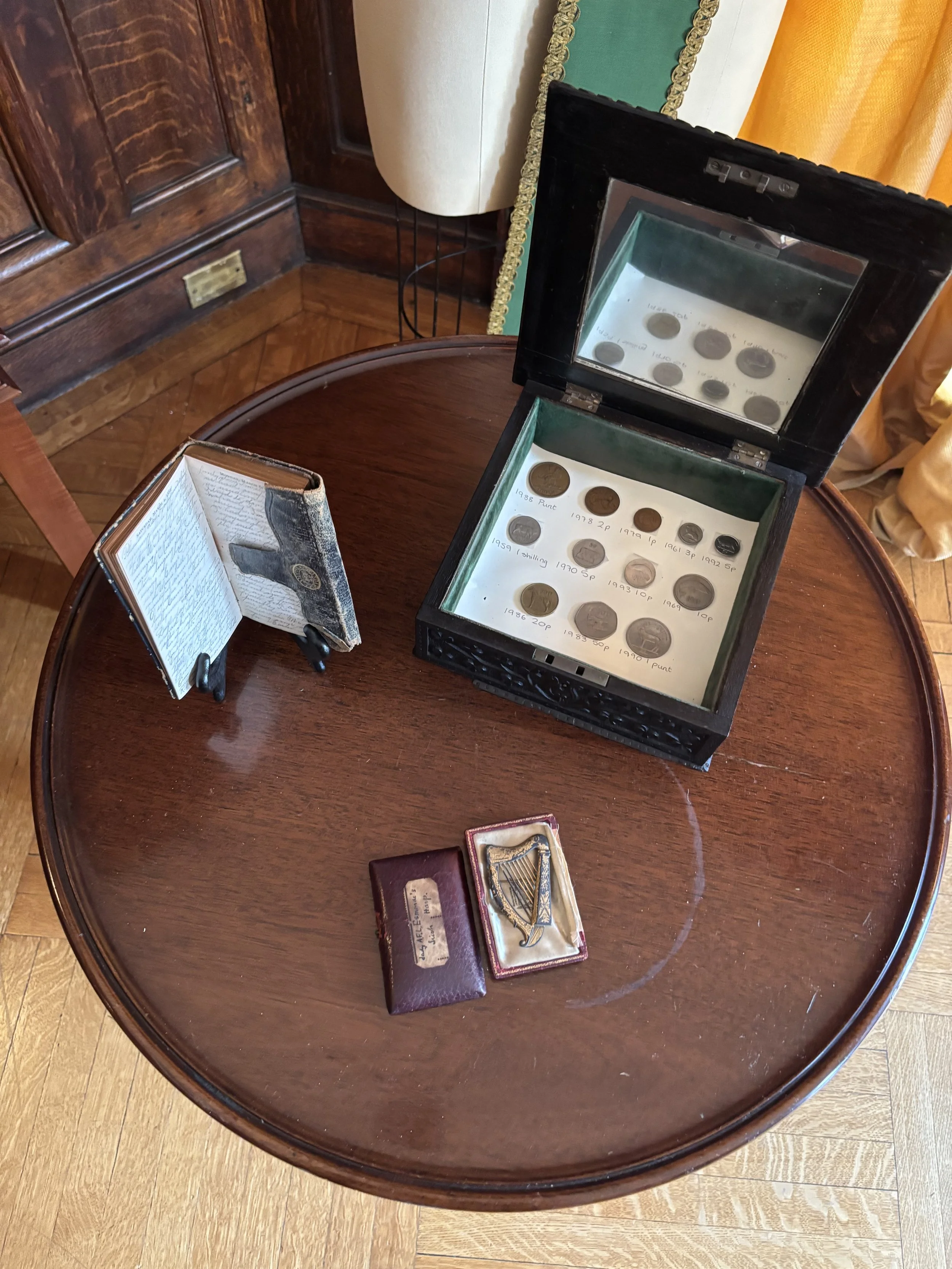Temporary Exhibition, July-September 2025
Treasures of the Archives
was a temporary exhibition open from July-September 2025.
The exhibition showcased some selected items from the collection of AIHS, to publicise the work being carried out within the archives to document, organize, and share our amazing collection.
Prepared by curator Aishling Connaughton Edwards with archivist Marcus Lindenburg.
Easter 1916 Tricolour Flag
Opening the exhibition, we featured one of the most fascinating individual items housed at the American Irish Historical Society: the tricolour flag of Easter 1916.
Prior to 1916, the 'green, white, and gold' flag was not the national flag of Ireland, but was used to symbolise the fusion of old ideals (green) and new (gold). As the political climate shifted, the flag grew in popularity as a symbol of unity (white) between Catholics (green) and Protestants (orange), later to be adopted as the official flag of Ireland.
On April 24th 1916, this flag was flown over the GPO during the events of the 1916 Easter Rising. With this flag flown at the helm of the rebellion, the tricolour became a recognisable symbol of Irish nationalism and independence. The flag is made from Irish linen and was commissioned by Sean MacDiarmada, secretary of the Irish Republican Brotherhood (IRB).
Bloodstains visible on the material hint at the "terrible beauty" born of the rebels’ sacrifice, which W. B. Yeats described in his poem; an estimated 485 people died fighting for Irish independence. Emblematically, the flag was captured by British forces, and housed only in private collections before finding its new home at AIHS.
During his evocative speech, Padraig Pearse, one of the most prominent figures in the 1916 Rising, commemorated Ireland’s ‘exiled children in America’ for their support in Ireland’s claim to independence.
‘There is always a clinging to the land of one’s birth.’
A handmade needlework tapestry by Charlotte Nestor Shiels, donated to AIHS by the artist’s granddaughter in 2018.
This artwork depicts multiple national flags, believed to be those of America, Italy, France, Scotland, Germany, Ireland, Switzerland, and the Netherlands. The use of some outdated flags suggests that the tapestry was created prior to 1937.
The Green Ensign flag, sometimes featuring the phrase ‘Erin Go Bragh’ (Ireland Forever), was used as a national symbol of Ireland prior to the tricolour, with a gold celtic harp (cláirseach) featuring prominently on a green background.
Personal Effects
Irish sash
Journal of Mary Cusey
Wooden crested box containing Irish pound coins
Harp brooch of Anna Frances Levins
This display was composed of various personal effects donated to the Society over the past 130 years.
Work is still being carried out to identify the origin of the green embroidered sash, however it was stored closeby to the harp pin, displayed here in its original box. This brooch was donated by the society’s former photographer, Anna Frances Levins, whose life and contributions will be honoured in a future exhibition.
The origin of the wooden box is currently unknown, but was previously used to store calling cards for early AIHS society members.
The journal was donated by Mary Cusey, along with various autograph books and school textbooks, dating to the mid 19th Century. This leather-bound journal is dated 1880, when the writer was in her teens, with the displayed page describing a 'dull' day in her life: ‘Mother made it even duller’.
Chronicon Scotorum
Or, ‘A Chronicle of Irish Affairs,’ attributed to O'Longhain in the year 1711.
One of the oldest books in our collection, this manuscript tells the history of the Irish people from their prehistoric and mythological roots until 1135 CE. This includes the arrival of Christianity, the birth, life, and death of St. Patrick, and the origins of many castles.
The text was intentionally archaised in a scholar’s binding, to create a Medieval effect.
Signed letter, photograph, and signature of Charles Stewart Parnell
A signed letter from Charles Stewart Parnell, dated January 29 1873. This letter was written a few years before Parnell began his career in politics as an MP in 1875.
In the letter, addressed to 'My Dear George,' Parnell expresses his regret that he did not make the visit to 'Phila' to spend more time with his friend, inviting him to visit him in Wicklow. He states that he is unsure if he will return to America, but will look back fondly on his time spent here.
Parnell returned in 1880 to garner support for the Irish Land League, which he co-founded in 1879. The Land League challenged the land tenure system, which gave ownership of Irish land to British colonial forces, a major contributing factor in the Great Hunger which had taken place less than thirty years before (1845-1852).
Bedell Bible, First Edition
Entitled, ‘Leabhuir na Seintiomna ar na Harriung go Gaidhig tre Churann agus clhuthrect an doctuir William Bedell’ - ‘The Holy Scriptures on the Haringeys into Gaelic through the Qur’an and the writings of Doctor William Bedell.’
This is a First Edition of the first Bible ever produced in the Irish language, translated into Irish by William Bedell (1571–1642) and printed forty years after his death, in 1685. Only 500 copies were produced, and of these, AIHS houses two.
William Bedell, an English cleric, believed there should be an Irish language Bible so that Irish speakers could access the holy text. With the help of native speakers, he completed this translation in 1642. Critics thought it was wrong for the Bible to be put into a “common tongue,” so the publication was halted until 1685.
This exhibition was introduced on July 28th, 2025, to showcase the cultural significance of the American Irish Historical Society and its collection. Work is currently being carried out to document, organize, and digitize the archives, with the aim of sharing the collection with academic researchers, AIHS members, and the American Irish community.
We are excited to facilitate further exploration of our collection, which will allow it to be utilized as an incredible and unique source of knowledge, historical insight, and cultural identity.
Come and visit us on Museum Mile to view our current exhibition, and experience Irish history that you have never seen before.









